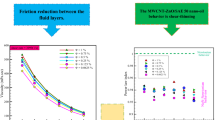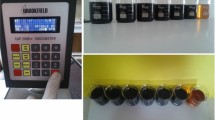Abstract
In this paper, viscosity of MWCNT (%50)–TiO2 (%50)/5W50 is investigated in temperature range of 5–55 °C, solid volume fractions of 0.05%, 0.1%, 0.25%, 0.5%, 0.75% and 1%, and shear rate range of 666.5–10,664 (s−1). Experimental results showed non-Newtonian behavior of enriched nano-engine oil. Nano-engine oil viscosity reduction (compared to 5W50 base oil) in some specific temperatures and solid volume fractions is one of the unique and interesting results of this research. Maximum viscosity reduction (− 11%) occurred in 15 °C and solid volume fraction of 0.05%, and maximum viscosity enhancement (+ 17%) was observed in 25 °C and solid volume fraction of 1%. The main goal of present study is to control viscosity increase of nanofluid after adding nanoparticles to the oil. Modeling and prediction of results were achieved via RSM and ANN methods.















Similar content being viewed by others
References
Jabbari F, Rajabpour A, Saedodin S. Viscosity of carbon nanotube/water nanofluid. J Therm Anal Calorim. 2019;135(3):1787–96.
Ramezanizadeh M, Ahmadi MA, Ahmadi MH, Nazari MA. Rigorous smart model for predicting dynamic viscosity of Al2O3/water nanofluid. J Therm Anal Calorim. 2018;137(1):307–16.
Fereidoon A, Saedodin S, Hemmat Esfe M, Noroozi MJ. Evaluation of mixed convection in inclined square lid-driven cavity filled with Al2O3/water nano-fluid. Eng Appl Comput Fluid Mech. 2013;7(1):55–65.
Esfe MH, Arani AAA, Niroumand AH, Yan WM, Karimipour A. Mixed convection heat transfer from surface-mounted block heat sources in a horizontal channel with nanofluids. Int J Heat Mass Transf. 2015;89:783–91.
Esfe MH, Motahari K, Sanatizadeh E, Afrand M, Rostamian H, Ahangar MRH. Estimation of thermal conductivity of CNTs-water in low temperature by artificial neural network and correlation. Int Commun Heat Mass Transf. 2016;76:376–81.
Esfe MH, Hajmohammad H, Moradi R, Arani AAA. Multi-objective optimization of cost and thermal performance of double walled carbonnanotubes/water nanofluids by NSGA-II using response surface method. Appl Therm Eng. 2017;112:1648–57.
Esfe MH, Hajmohammad H, Toghraie D, Rostamian H, Mahian O, Wongwises S. Multi-objective optimization of nanofluid flow in double tube heat exchangers for applications in energy systems. Energy. 2017;137:160–71.
Esfe MH, Hajmohammad MH. Thermal conductivity andviscosity optimization of nanodiamond-Co3O4/EG (40: 60) aqueous nanofluid using NSGA-II coupled with RSM. J Mol Liq. 2017;238:545–52.
Esfe MH, Esfandeh S, Rejvani M. Modeling of thermal conductivity of MWCNT-SiO 2 (30: 70%)/EG hybrid nanofluid, sensitivity analyzing and cost performance for industrial applications. J Therm Anal Calorim. 2018;131(2):1437–47.
Esfe MH, Esfandeh S. Rheological behavior of CuO/EG: W (20: 80 v/v) nanofluid from a thermal perspective. J Therm Anal Calorim. 2019;135(1):61–72.
Dehkordi RA, Esfe MH, Afrand M. Effects of functionalized single walled carbon nanotubes on thermal performance of antifreeze: an experimental study on thermal conductivity. Appl Therm Eng. 2017;120:358–66.
Sepyani K, Afrand M, Esfe MH. An experimental evaluation of the effect of ZnO nanoparticles on the rheological behavior of engine oil. J Mol Liq. 2017;236:198–204.
Esfe MH, Emami MRS, Amiri MK. Experimental investigation of effective parameters on MWCNT–TiO2/SAE50 hybrid nanofluid viscosity. J Therm Anal Calorim. 2019;137(3):743–57.
Maddah H, Aghayari R, Ahmadi MH, Rahimzadeh M, Ghasemi N. Prediction and modeling of MWCNT/carbon (60/40)/SAE 10 W 40/SAE 85 W 90 (50/50) nanofluid viscosity using artificial neural network (ANN) and self-organizing map (SOM). J Therm Anal Calorim. 2018;134(3):2275–86.
Pourpasha H, Heris SZ, Asadi A. Experimental investigation of nano-TiO2/turbine meter oil nanofluid. J Therm Anal Calorim. 2019. https://doi.org/10.1007/s10973-019-08155-2.
Naddaf A, Heris SZ. Density and rheological properties of different nanofluids based on diesel oil at different mass concentrations. J Therm Anal Calorim. 2019;135(2):1229–42.
Malý M, Moita AS, Jedelsky J, Ribeiro APC, Moreira ALN. Effect of nanoparticles concentration on the characteristics of nanofluid sprays for cooling applications. J Therm Anal Calorim. 2019;135(6):3375–86.
Eshaghi A, Mojab M. Hydrophilicity of silica nano-porous thin films: calc fects of multi-walled carbon nanotubes on rheological behavior of engine ination temperature effects. J Nanostruct. 2017;7(2):127–33. https://doi.org/10.22052/jns.2017.02.006.
Esfe MH, Zabihi F, Rostamian H, Esfandeh S. Experimental investigation, model development of the non-Newtonian behavior of CuO–MWCNT-10w40 nano-lubricant for lubrication purposes. J Mol Liq. 2017;249:677–87. https://doi.org/10.1016/j.molliq.2017.11.020.
Esfe MH, Esfandeh S. Investigation of rheological behavior of hybrid oil based nanolubricant-coolant applied in car engines and cooling equipments. Appl Therm Eng. 2017;131:1026–33.
Esfe MH, Tatar A, Ahangar MRH, Rostamian H. A comparison of performance of several artificial intelligence methods for predicting the dynamic viscosity of TiO2/SAE 50 nano-lubricant. Phys E Low Dimens Syst Nanostruct. 2017;96:85–93.
Esfe MH, Saedodin S, Rejvani M, Shahram J. Experimental investigation, model development and sensitivity analysis of rheological behavior of ZnO/10W40 nano-lubricants for automotive applications. Physica E. 2017;90:194–203.
Corcione M. Empirical correlating equations for predicting the effective thermal conductivity and dynamic viscosity of nanofluids. Energy Convers Manag. 2011;52(1):789–93.
Aberoumand S, Jafarimoghaddam A. Experimental study on synthesis, stability, thermal conductivity and viscosity of Cu–engine oil nanofluid. J Taiwan Inst Chem Eng. 2017;71:315–22. https://doi.org/10.1016/j.jtice.2016.12.035.
Attari H, Derakhshanfard F, Darvanjooghi MHK. Effect of temperature and mass fraction on viscosity of crude oil-based nanofluids containing oxide nanoparticles. Int Commun Heat Mass Transf. 2017;82:103–13. https://doi.org/10.1016/j.icheatmasstransfer.2017.02.007.
Asadi A, Asadi M, Rezaee M, Siahmargoi F. The effect of temperature and solid concentration on dynamic viscosity of MWCNT/MgO (20–80)–SAE50 hybrid nano-lubricant and proposing a new correlation: an experimental study. Int Commun Heat Mass Transf. 2016;78:48–53. https://doi.org/10.1016/j.icheatmasstransfer.2016.08.021.
Asadi M, Asadi A. Dynamic viscosity of MWCNT/ZnO–engine oil hybrid nanofluid: an experimental investigation and new correlation in different temperatures and solid concentrations. Int Commun Heat Mass Transf. 2016;76:41–5. https://doi.org/10.1016/j.icheatmasstransfer.2016.05.019.
Afrand M, Najafabadi KN, Akbari M. Effects of temperature and solid volume fraction on viscosity of SiO2–MWCNTs/SAE40 hybrid nanofluid as a coolant and lubricant in heat engines. Appl Therm Eng. 2016;102:45–54. https://doi.org/10.1016/j.applthermaleng.2016.04.002.
Moghaddam MA, Motahari K. Experimental investigation, sensitivity analysis and modeling of rheological behavior of MWCNT–CuO (30–70)/SAE40 hybrid nano-lubricant. Appl Therm Eng. 2017;123:1419–33. https://doi.org/10.1016/j.applthermaleng.2017.05.200.
Aghaei A, Khorasanizadeh H, Sheikhzadeh GhA. Experimental measurement of the dynamic viscosity of hybrid engine oil–Cuo–MWCNT nanofluid and development of practical viscosity correlation. Modares Mech Eng. 2016;16(12):518–24 (in Persian).
Esfe MH, Afrand M, Yan W-M, Yarmand H, Toghraie D, Dahari M. Effects of temperature and concentration on rheological behavior of MWCNTs/SiO2(20–80)-SAE40 hybrid nano-lubricant. Int Commun Heat Mass Transf. 2016;76:133–8. https://doi.org/10.1016/j.icheatmasstransfer.2016.05.015.
Esfe MH, Sarlak MR. Experimental investigation of switchable behavior of CuO–MWCNT (85%–15%)/10 W-40 hybrid nano-lubricants for applications in internal combustion engines. J Mol Liq. 2017;242:326–35. https://doi.org/10.1016/j.molliq.2017.06.075.
A, Saedodin S, Esfe MH, Rostamian SH. Investigation of rheological behavior of MWCNT (COOHfunctionalized)/MgO-engine oil hybrid nanofluids and modelling the results with artificial neural networks. J Mol Liq. 2016;241:173–81. https://doi.org/10.1016/j.molliq.2017.05.121.
Esfe MH, et al. Experimental investigation on non-Newtonian behavior of Al2O3–MWCNT/5W50 hybrid nano-lubricant affected by alterations of temperature, concentration and shear rate for engine applications. Int Commun Heat Mass Transf. 2017;82:97–102.
Esfe MH, Rostamian H, Sarlak MR, Rejvani M, Alirezaie A. Rheological behavior characteristics of TiO2–MWCNT/10w40 hybrid nano-oil affected by temperature, concentration and shear rate: an experimental study and a neural network simulating. Phys E Low Dimens Syst Nanostruct. 2017;94:231–40. https://doi.org/10.1016/j.physe.2017.07.012.
Esfe MH, Rostamian H. Non-Newtonian power-law behavior of TiO2/SAE 50 nano-lubricant: an experimental report and new correlation. J Mol Liq. 2017;232:219–25. https://doi.org/10.1016/j.molliq.2017.02.014.
Esfe MH, Abad ATK, Fouladi M. Effect of suspending optimized ratio of nano-additives MWCNT-Al2O3 on viscosity behavior of 5W50. J Mol Liq. 2019;285:572–85.
Esfe MH, Esfandeh S, Alirezaie A. A novel experimental investigation on the effect of nanoparticles composition on the rheological behavior of nano-hybrids. J Mol Liq. 2018;269:933–9.
Esfe MH, Esfandeh S, Niazi S. An experimental investigation, sensitivity analysis and RSM analysis of MWCNT (10)-ZnO (90)/10W40 nanofluid viscosity. J Mol Liq. 2019;111020.
Esfe MH, Alirezaie A, Rejvani M. An applicable study on the thermal conductivity of SWCNT-MgO hybrid nanofluid and price-performance analysis for energy management. Appl Therm Eng. 2017;111:1202–10.
Esfe MH, Arani AAA, Esfandeh S. Experimental study onrheological behavior of monograde heavy-duty engine oil containing CNTs and oxide nanoparticles with focus on viscosity analysis. J Mol Liq. 2018;272:319–29.
Esfe MH. On the evaluation of the dynamic viscosity of non-Newtonian oil based nanofluids. J Therm Anal Calorim. 2019;135(1):97–109.
Esfe MH, Arani AAA, Esfandeh S. Improving engine oil lubrication in light-duty vehicles by using of dispersing MWCNT and ZnO nanoparticles in 5W50 as viscosity index improvers (VII). Appl Therm Eng. 2018;143:493–506.
Esfe MH, Saedodin S, Mahian O, Wongwises S. Efficiency of ferromagnetic nanoparticles suspended in ethylene glycol for applications in energy devices: effects of particle size, temperature, and concentration. Int Commun Heat Mass Transf. 2014;58:138–46.
Sarafraz MM, Nikkhah V, Nakhjavani M, Arya A. Thermal performance of a heat sink microchannel working with biologically produced silver-water nanofluid: experimental assessment. Exp Therm Fluid Sci. 2018;91:509–19.
Rostamian SH, Biglari M, Saedodin S, Esfe MH. An inspection of thermal conductivity of CuO-SWCNTs hybrid nanofluid versus temperature and concentration using experimental data, ANN modeling and new correlation. J Mol Liq. 2017;231:364–9.
Esfe MH. The investigation of effects of temperature and nanoparticles volume fraction on the viscosity of copper oxide-ethylene glycol nanofluids. Period Polytech Chem Eng. 2018;62(1):43–50.
Esfe MH, Razi P, Hajmohammad MH, Rostamian SH, Sarsam WS, Arani AAA, Dahari M. Optimization, modeling and accurate prediction of thermal conductivity and dynamic viscosity of stabilized ethylene glycol and water mixture Al2O3 nanofluids by NSGA-II using ANN. Int Commun Heat Mass Transf. 2017;82:154–60.
Esfe MH, Rostamian H, Toghraie D, Yan WM. Using artificial neural network to predict thermal conductivity of ethylene glycol with alumina nanoparticle. J Therm Anal Calorim. 2016;126(2):643–8.
Salari M, Malekshah EH, Esfe MH. Three dimensional simulation of natural convection and entropy generation in an air and MWCNT/water nanofluid filled cuboid as two immiscible fluids with emphasis on the nanofluid height ratio’s effects. J Mol Liq. 2017;227:223–33.
Arya A, Sarafraz MM, Shahmiri S, Madani SAH, Nikkhah V, Nakhjavani SM. Thermal performance analysis of a flat heat pipe working with carbon nanotube-water nanofluid for cooling of a high heat flux heater. Heat Mass Transf. 2018;54:985–97.
Salari E, Peyghambarzadeh M, Sarafraz MM, Hormozi F. Boiling heat transfer of alumina nano-fluids: role of nanoparticle deposition on the boiling heat transfer coefficient. Period Polytech Chem Eng. 2016;60:252–8.
Sarafraz MM. Experimental investigation on pool boiling heat transfer to formic acid, propanol and 2-butanol pure liquids under the atmospheric pressure. 2013.
Sarafraz MM, Peyghambarzadeh SM. Influence of thermodynamic models on the prediction of pool boiling heat transfer coefficient of dilute binary mixtures. Int Commun Heat Mass Transf. 2012;39:1303–10.
Rostamian H, Lotfollahi MN. A novel statistical approach for prediction of thermal conductivity of CO2 by Response Surface Methodology. Phys A: Stat Mech Appl. 2019;527:121175.
Rostamian, H., & Lotfollahi, M. N. (2019). A new correlation method for estimating thermal conductivity of carbon dioxide in liquid, vapor and supercritical phases. Period Polytech Chem Eng. https://doi.org/10.3311/PPch.12754.
Unal R, Braun RD, Moore AA, Lepsch RA. Response surface model building using orthogonal arrays for computer experiments. NASA Langley Technical Report Server; 1997.
Najafi-Marghmaleki A, Khosravi-Nikou MR, Barati-Harooni A. A new model for prediction of binary mixture of ionic liquids + water density using artificial neural network. J Mol Liq. 2016;220:232–7.
Esmaeili-Jaghdan Z, Shariati A, Nikou MRK. A hybrid smart modeling approach for estimation of pure ionic liquids viscosity. J Mol Liq. 2016;222:14–27.
Kurt H, Kayfeci M. Prediction of thermal conductivity of ethylene glycol–water solutions by using artificial neural networks. Appl Energy. 2009;86:2224–48.
Durairaj M, Science C. Applications of artificial neural network for IVF data analysis and prediction. J Eng Comput. 2013;2:11–5.
Fausett LV. Fundamentals of neural networks. Upper Saddle River: Prentice-Hall; 1994.
Author information
Authors and Affiliations
Corresponding author
Additional information
Publisher's Note
Springer Nature remains neutral with regard to jurisdictional claims in published maps and institutional affiliations.
Rights and permissions
About this article
Cite this article
Hemmat Esfe, M., Esfandeh, S. & Rostamian, H. Proposing a nano-approach to modify viscosity behavior of SAE 5W50 as light road vehicles lubricant. J Therm Anal Calorim 139, 975–989 (2020). https://doi.org/10.1007/s10973-019-08447-7
Received:
Accepted:
Published:
Issue Date:
DOI: https://doi.org/10.1007/s10973-019-08447-7




